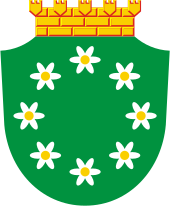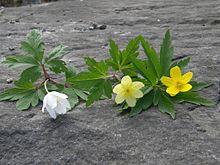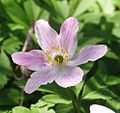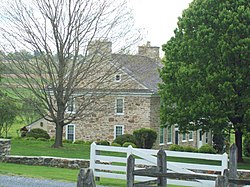Anemonoides nemorosa
| Anemonoides nemorosa | |
|---|---|
 | |
| Scientific classification | |
| Kingdom: | Plantae |
| Clade: | Tracheophytes |
| Clade: | Angiosperms |
| Clade: | Eudicots |
| Order: | Ranunculales |
| Family: | Ranunculaceae |
| Genus: | Anemonoides |
| Species: | A. nemorosa |
| Binomial name | |
| Anemonoides nemorosa (L.) Holub | |
 | |
| Synonyms[1] | |
| |
Anemonoides nemorosa (syn. Anemone nemorosa), the wood anemone, is an early-spring flowering plant in the buttercup family Ranunculaceae, native to Europe.[1] Other common names include windflower, thimbleweed, and smell fox, an allusion to the musky smell of the leaves. It is a perennial herbaceous plant growing 5–15 cm (2–6 in) tall.
Description
Anemonoides nemorosa is a rhizomatous herbaceous perennial plant less than 30 centimetres (12 in) in height. The compound basal leaves are palmate or ternate (divided into three lobes).[2]: 106 They grow from underground root-like stems called rhizomes and die back down by mid summer (summer dormant).
The plants start blooming in spring, March to May in the British Isles[3]: 28 soon after the foliage emerges from the ground. The flowers are solitary, held above the foliage on short stems, with a whorl of three palmate or palmately-lobed leaflike bracts beneath. The flowers are 2 centimetres (0.8 in) diameter, with six or seven (and on rare occasions eight to ten) tepals (petal-like segments) with many stamens. In the wild the flowers are usually white but may be pinkish, lilac or blue, and often have a darker tint on the backs of the tepals.
유사종
노란 나무 아네모네(Anemonoides ranunculoides)는 약간 작으며, 노란 꽃을 피우고 있으며 보통 기저 잎이 없다.[2]
비슷한 그늘진 곳에서 자라는 나무소럴 옥살리스 아세토셀라는 테르나이트하고 클로버 같은 잎과 흰 꽃잎 5개, 석회 5개로 더 작은 꽃으로 쉽게 구별할 수 있다.[3][4]
분포 및 서식지

아네모노이드 네모로사의 토착 범위는 유럽을 넘어 서아시아까지 뻗어 있으며 터키의 코카서스 산맥까지 남쪽에 이른다. 뉴질랜드 등에 소개되었다.[1] 북아메리카에서는 뉴펀들랜드, 퀘벡, 매사추세츠 주의 유명한 유적지에 귀화 인구가 있다.[5][6]
A. 네모로사는 종종 그늘진 숲에서 발견된다.[4] 이 종은 영국 섬에서[3] 흔하지만 그곳에서 세기에 6피트 정도 천천히 퍼져나가기 때문에 종종 고대 삼림지대의 지표로 사용된다.[7]
생태학
그 꽃들은 곤충, 특히 호버파리에 의해 수분된다.[8] 그 씨앗들은 신갈이다.[2]
재배
많은 품종이 정원용으로 선택되었다. The RHS Plant Finder 2008–2009년 영국의 탁아소에서 판매되는 70개의 품종을 나열했다. 가장 널리 이용 가능한 일부는 다음과 같다.
- '알바 플레나' - 이중 화이트
- '알레니'agm[9] - 종종 7개의 꽃잎이 있는 라벤더 청색의 큰 꽃(보육원 제임스 앨런의 이름을 딴 이름)
- 'Bowles' Purple' - 보라색 꽃(E.A.의 이름을 딴 이름) Bowles, 식물인, 정원작가)
- 'Bracteata Pleniflora' - 녹색 줄무늬가 있고 주름살이 많은 흰색의 이중 꽃
- '로빈슨아나아나[10]'agm - 연한 라벤더-파란 꽃(William Robinson, 식물학자, 정원 작가)
- '로얄 블루' - 보라색 등이 있는 진한 파란색 꽃
- 'Vestal'agm[11] - 흰색, 아네모네 중심 꽃
- 'Virescens'agm[12] - 작은 원뿔 모양의 잎으로 변이된 꽃
agm으로 표시된 이들은 왕립원예협회 정원공로 수상자들이다.
Anemonoides × lipsiensis, a hybrid between A. nemorosa and A. ranunculoides,[13] has pale yellow flowers; A. × lipsiensis 'Pallida' is the best-known result of this cross. It has also been awarded the AGM.[14]
Gallery
Form in Chemnitz, Germany
Colonial growth in Radziejowice, Poland
Double-flowered cultivar in Lincolnshire, England
Pink-flowered plant in Hohenlohe, Germany
References
- ^ a b c "Anemonoides nemorosa (L.) Holub". Plants of the World Online. Royal Botanic Gardens, Kew. Retrieved 21 July 2020.
- ^ a b c Stace, C. A. (2010). New Flora of the British Isles (Third ed.). Cambridge, U.K.: Cambridge University Press. p. 88. ISBN 9780521707725.
- ^ a b c Clapham, A.R., Tutin, T.G. and Warburg, E.F. (1981). Excursion Flora of the British Isles (3 ed.). Cambridge University Press. ISBN 0521232902.CS1 maint: uses authors parameter (link)
- ^ a b Parnell, J. and Curtis, T. 2012. Webb's An Irish Flora. Cork University Press. ISBN 978-185918-4783
- ^ Dutton, Bryan E.; Keener, Carl S.; Ford, Bruce A. (1997). "Anemone". In Flora of North America Editorial Committee (ed.). Flora of North America North of Mexico (FNA). 3. New York and Oxford. Retrieved 2020-11-28 – via eFloras.org, Missouri Botanical Garden, St. Louis, MO & Harvard University Herbaria, Cambridge, MA.
- ^ " Anemone nemorosa". County-level distribution map from the North American Plant Atlas (NAPA). Biota of North America Program (BONAP). 2014. Retrieved 28 November 2020.
- ^ Plantlife - Wood Anemone
- ^ Blank, S. and M. Wulf. on seed production and pollinator biology of Anemone nemorosa (Buschwindröschen). Leibniz-Centre for Agricultural Landscape Research (ZALF). 2008.
- ^ "Anemone nemorosa 'Allenii'". RHS. Retrieved 12 April 2020.
- ^ "Anemone nemorosa 'Robinsoniana'". RHS. Retrieved 12 April 2020.
- ^ "Anemone nemorosa 'Vestal'". RHS. Retrieved 12 April 2020.
- ^ "Anemone nemorosa 'Virescens'". RHS. Retrieved 12 April 2020.
- ^ Astuti, Giovanni; Marconi, Giancarlo; Pupillo, Paolo; Peruzzi, Lorenzo (17 May 2019). "Anemonoides × lipsiensis comb. nov. (Ranunculaceae), new for the Italian flora". Italian Botanist. 7: 101–105. doi:10.3897/italianbotanist.7.35004. Retrieved 21 July 2020.
- ^ "Anemone × lipsiensis 'Pallida'". RHS. Retrieved 12 April 2020.
Further reading
- Shirreffs, D. A. 1985. Anemone nemorosa L. Journal of Ecology 73: 1005-1020.
- Philip, C. (2008). Plant Finder 2008-2009. ISBN 978-1-4053-3190-6.
- Plantlife - Wood Anemone










